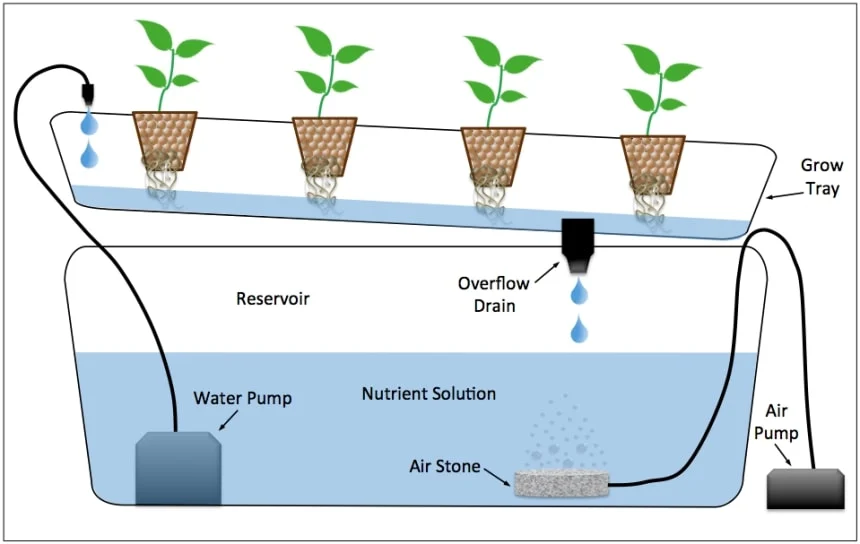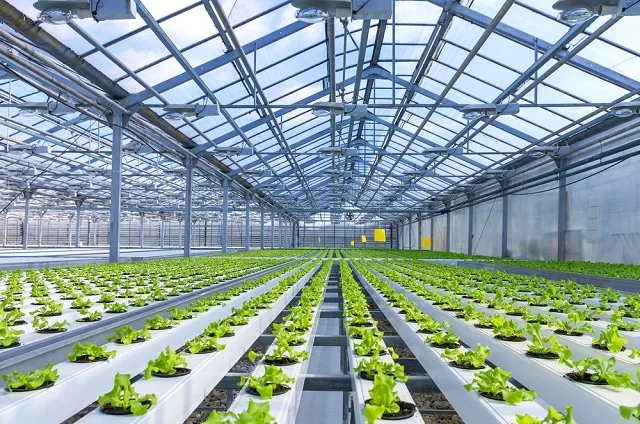Hydroponics. I have always been conservative and continue to be so with trying to be as self sufficient as possible. I love to grow my own food. From the chickens I raise to the vegetables I grow to the bread I bake with my fresh grown herbs. Knowing what I am eating and where it came from is important to me. Also, between Covid, salmonella scares, high prices and food shortages, it just makes sense to grow and raise my own food and you can too.
Fall and spring are my favorite times of the year for working outside in my garden. Unfortunately, they seem so much shorter than winter and summer. As I get older, I cannot tolerate the heat in the summer to grow as much food as I want outside. So, I have a hydroponic system set up in my house to grow vegetables without having to suffer the heat and bugs. I grow a lot from seeds, especially salad greens, but I also propagate a lot of my plants as well. Especially my orchids!
Soil VS Hydroponics
It is said that the debate between soil vs hydroponics depends on the location and size of your grow space. However, I find this not to be true. You can grow many vegetables in a small garden when you plan it well. You don’t need a huge area to be able to have fresh vegetables all year round. Just different varieties. Either technique will get the results you are looking for. I prefer to start my plants hydroponically, then transfer them to soil after they are big and strong when the weather is right!
A good healthy soil if full of good bacteria and micro organisms that withstand nutrients and water being added once per week. I do have a compost pile that has what I call ‘black gold’. It is great for the garden, but it is also a lot of work to maintain. However, it is worth it. I mainly plant fast growing vegetables like radishes and carrots outside. Also those tall vegetables such as corn and tomatoes, and the ones that come back each year like asparagus into the ground. I do have a lot of vegetables and herbs outside in pots after I start them inside hydroponically. Plants metabolize slower when started in dirt outside as the nutrients are not freely available as in a hydroponic set up. Not to mention the bugs and heat.
The Future of Food
More and more number of people are getting curious about how to grow a hydroponic garden. Hydroponics or hydroponic farming is a method for cultivating plants and vegetables using mineral nutritious solutions in water instead of agricultural land. The word hydroponics comes from the Greek, ‘hydro’ meaning water and ‘ponos’ meaning work.
Growing hydroponically is fast, efficient and you are able harvest your crop multiple times in a year. Especially lettuce. I cut fresh lettuce and herbs for my salad almost every night as it is highly productive.
Hydroponics can efficiently generate food where you have desert sand, ocean water, mountainous regions too steep to farm or arctic communities. Where skyrocketing land prices have driven out traditional agriculture, hydroponics can provide you with healthy food such as fresh salad greens, herbs and cut ornamental flowers. Grow fresh vegetables that are unavailable for much of the year. The development and use of hydroponics have enhanced the economic well being of many communities throughout the world.
This gardening is a revolution in a garden free of dirt. As the population has grown and the space available to grow plants has declined, we need hydroponics gardening more than ever. It is an easy and efficient way of growing plants. Plants that grow hydroponically are much healthier compared to plants in the soil, because all the necessary nutrients go directly to the roots.
Advantages of Hydroponics
There are many advantages to growing plants with the hydroponic method. You can grow organic food without the use of harmful pesticides and fertilizers. Also, you save a lot of water as this method uses re-circulated water with this specialized technique. This is excellent news for those residing in desert regions or in locations where good water is hard to find.
Plant growth with hydroponics is much faster as nutrients are available immediately for the roots to take in. Roots receive a balanced nutrient solution dissolved in water with all the elements essential for the development of plants to grow. It is easier to directly add exactly what micro or macro nutrients and have control over the plants nutrients cycles.
With hydroponics gardening, have fruits and vegetables throughout the year! This means you can enjoy even seasonal fruits and vegetables at any time without paying extravagant prices for them. Additionally, you don’t have to worry about the freshness and purity of your plants because they grow under your control. This not only guarantees the very best quality, but in addition takes the guess work out of farming. This helps you to relax and enjoy gardening while being safe and comfortable in your home.
You Can Grow Hydroponics
Hydroponic kits are available online or at any garden supply for beginners. I bought my first one online, but the other day I noticed that Walmart had them as well. For the novice, this is the easiest way to start. Everything you need to start is in the kit along with the directions. You just supply the water. Maintenance of your hydroponic garden is almost next to nothing. Furthermore, it is a cost effective method of gardening because you do not need to buy a bunch of bags of potting soil. Better yet, absolutely no weeding and plants develop more rapidly. It is actually 30-50% quicker than plants cultivated in soil.
Hydroponics gardening is gaining a lot of popularity among amateur and professional gardeners as more and more people are realizing the importance of saving the environment. So, if you are seeking a hobby or perhaps a new Eco-friendly approach to farming, hydroponic garden is certainly worth trying, just be aware that when you begin you may not want to quit!!! The fruits of your labor will be too good to quit! I certainly never plan to quit. I just keep adding more!!! You will too!
Reasons to Grow Hydro
Why grow hydroponically? As soil needs fertilizers and supplements, the levels of oxygen at the roots of a plant grown in soil are relatively low compared to a hydroponics system. In soil, plants have to compete with other organisms at the root, such as fungi and bacteria, to get enough nutrients and oxygen. Therefore, plants grow fastest in a hydroponic sterile root environment with plenty of both. Pure and uninterrupted absorption of oxygen, water and minerals provide everything that a healthy plant needs.
Hydroponic growing can also help to conserve water and allows for much higher yields for both your indoor and outdoor plants. Change the water every week. I use the water that I empty to feed my plants outdoors and my house plants. It really helps them thrive as well.
Benefits of a Sterile Environment
Maintaining a sterile environment has other advantages when cultivating medicinal plants. In hydroponics, there is no microbial life introduced from the medium (or potential pathogens and insects) into the growing environment because the environment is sterile. So in addition to plants being able to grow faster in controlled, oxygen-rich conditions, there are many of the other benefits: re-usability, water conservation and maintaining a pathogen-free environment.
Faster Growth Rates
For a lot of growers, especially those who follow the guidelines outlined here, using a hydroponic technique will lead to increased growth rates. That means harvesting in less time, which means shorter waiting periods between harvests and achieving more crops. And if you get serious about hydro, it can mean bigger yields every harvest as well.
While hydroponic growing is a powerful tool, follow some fundamentals for success. In other words, learn the essentials first. Growing with hydroponics is not complicated or even expensive. Just manage your crop, budget and expectations accordingly, and you’ll be sure to have some fun while sticking to the hydro fundamentals.
Mediums
Water is the growing medium in hydroponics. The fundamental difference between soil growing and hydroponics: in soil, the food for the plant is in the soil itself, but when plants grow hydroponically, it is with the fertilizers and supplements you provide. By the same token, while this promises incredible crop-feeding power, it also makes hydroponics less forgiving than soil. In hydro, you can see changes in your plants within hours, while with dirt it can take days and may be too late to save.
My hydroponic system consists of plastic baskets and grow sponges. They support the plants as the bare roots bath in an oxygen-rich nutrient solution. The baskets are reusable, and a new sponge is placed for each new seed after harvest.
Water Quality
For healthy crops with increased growth rates and yields, you want to use the best quality water possible. Distilled water is best. Well water and even city water have impurities and may even be toxic. If the water doesn’t taste good to you, it probably won’t be good for your plants.
Dissolved Oxygen
This is the magic of hydroponics. Dissolved oxygen levels are often the most overlooked for generating a higher degree of health, growth and yield. Plants with elevated oxygen levels at the root are less prone to problems and can use nutrients more efficiently. When adding aeration to the root systems the amount of fertilizer used is much less than conventional soil or soil-less growing methods. The plants will process the nutrients more efficiently with the high levels of oxygen available to the roots.
A hydroponic system needs aeration. The kits have the pump system included. Pumping air into the solution is a highly effective way to introduce more oxygen to the roots. In this respect, it’s like an aquarium, where the fish need oxygen in the water.
Root Temperature
Hydroponics need a level of consistent temperature and amount of solution that surrounds the roots. Outside, the soil stays an even temperature even when it’s hot. The same principle applies here. Cooler water holds more dissolved oxygen than warmer water. A reservoir temperature of 19°C/67°F is best.
The pH level
The reason that the plant and the nutrient solution is so direct in hydroponics is that there is nothing between the nutrients and the roots. Plants absorb nutrients at different rates depending on PH. PH is a scale from acidity, or low pH, to alkalinity, or high pH. In hydroponics the optimal pH is usually around 5.8. Some nutrients are much better suited to hydroponics.
Hydroponic Mineral Solution
In hydroponics, especially recirculating ones, a mineral-based solution is recommended over an organic one. Soil is a better place for organics, where ingredients can break down with the help of microbes and are released through the roots.
In hydro, the concentration changes as the plants use up nutrients and water is added. If the concentration is too weak, the plants grow slowly and yield poorly. Too high will cause nutrient burn which can stunt growth and lower yields. Plants need less food when young and need more during the mid or peak stage.
In a hydro setup, the root area will remain sterile and the nutrients will be supplied by way of minerals rather than biological ingredients. In doing so, you’ll see faster growth, healthier plants and more consistent results. Some new products add a special type of chlorine-based molecule into the solution, helping to keep the roots sterile without causing any harm. Chlorine molecule quickly and safely break down after it’s done the job.
I hope you have enjoyed my blog and I thank you for reading it. Now, sit back with a glass of premium, fine wine and just imagine all the healthy food you will grow and eat! Oh, and you can get this awesome wine delivered to your door every month!! Read all about it on my Wine Blog.





